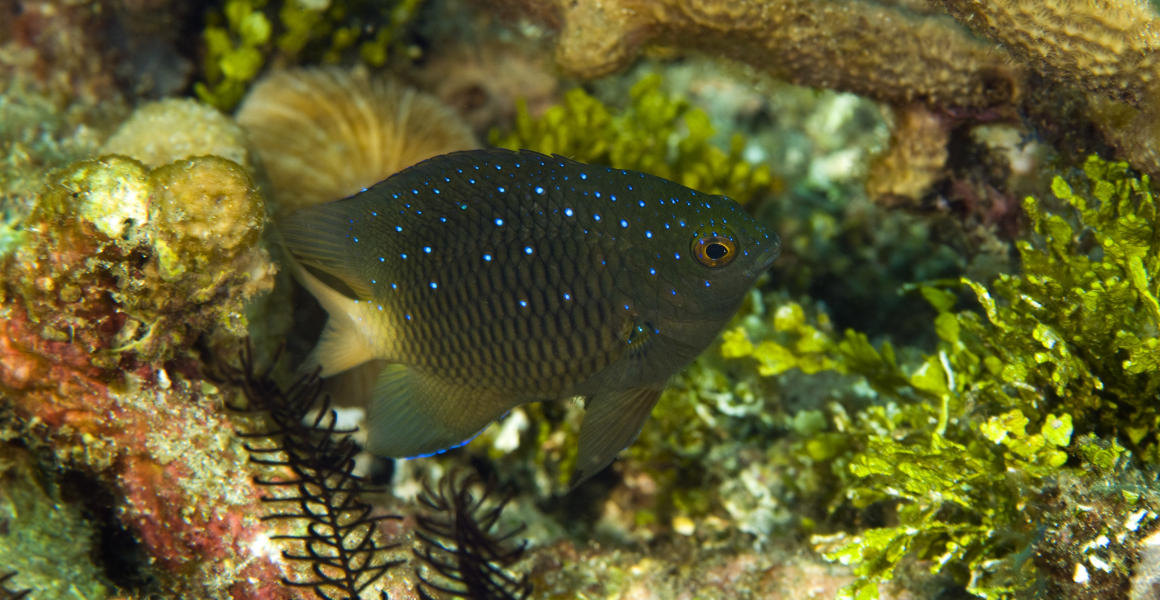
Invasive rats are affecting the behaviour of algae-farming fish
Invasive rats are devastating tropical islands, with effects reaching far beyond the land.
Rodents are some of the most difficult invasive species to eradicate, being very adaptable and with a broad diet that can extend from grains and fruits to insects and even chicks.
A new study, published in the journal Nature Ecology & Evolution, has revealed that their voracious appetite for young birds is affecting nutrient cycling on tropical islands to such an extent that the oceans around them are also changing.
Damselfish dependent on algae are forced to have larger territories to find enough food to survive, which as a result is also changing their behaviour.
Dr Rachel Gunn, the lead author of the research, says, ‘Jewel damselfish around rat-free islands aggressively defend their turf algae because the higher enriched nutrient content means they get "more for their money", and this makes it worth the energy cost of defence.’
‘Conversely, fish around rat-infested islands behave less aggressively. We believe that the presence of rats is lowering the nutritional benefit of the turf to the extent that it is almost not worth fighting for, which is what we are observing with these behaviour changes.’
Co-author Dr Sally Keith adds, ‘Changes in behaviour are often the first response of animals to environmental change, and can scale up to affect if, how and when species can live alongside one another.’
‘Our research is the first to show that these broader impacts can even be felt across biomes, from terrestrial invaders to marine farmers.’

Black rats are an invasive species of many of the world’s island, including many in the Chagos Archipelago. Image © Jesus Cobaleda/Shutterstock
Why are invasive rodents a problem?
Tropical islands represent some of the world’s most unusual ecosystems. Cut off from the rest of the world, and often with no large predators, any animals that find their way to these islands can evolve in different directions to their mainland relatives.
However, this same isolation that contributed to their evolution can also pose a risk if predators arrive. Species like the dodo, for example, were pushed into extinction by the introduction of invasive species such as macaques and cats.
Frequent unintended introductions are rodents, which stowed away on ships before coming ashore when the ship made it to land. Able to breed rapidly and consume almost anything, these animals have become one of the most prolific pests of island life, with three species of rat having been introduced to 80% of the world’s island groups.
Seabirds, especially those which nest together in large numbers, are particularly vulnerable to invasive rodents. In the Chagos Archipelago, where this latest study took place, seabird densities are 720 times lower on islands where rats are present, resulting in much less nutrient-rich bird poo being produced.
As a result, levels of nutrients such as nitrogen are 251 times lower on rat-infested islands, which has knock-on effects for the rest of the ecosystem. It hinders the growth of organisms at the bottom of food chains, such as plants and invertebrates, which in turn impacts on other terrestrial species.

A number of damselfish species tend to algal areas, and defend their patch from competitors. Image © Dr Rachel Gunn
How are farming damselfish being affected?
While changes on land may be more easily noticeable, the loss of nutrients is also causing changes in the oceans. Nutrients from bird poo which are washed off the land can enhance the growth of corals and marine fish, contributing to the biodiversity of coral reefs.
Healthy reefs contain a mixture of corals and algae, with a variety of algal species forming large mats. These turf algae are an important source of food for many reef organisms, with some species of herbivorous damselfish known to ‘farm’ them.
The damselfish are capable of selectively removing, or weeding out, unpalatable algae from their patch, as well as preparing new areas for algae to grow by removing sediment from areas of rock.
A recent study has even suggested that one species may have domesticated shrimps to provide nutrients for its algae.
The damselfish will also actively defend their algal farms from rivals and other herbivores. Around rat-infested islands, however, the study found that farming damselfish tend to bite and ram competitors less often.
While the algal cover was the same around islands with rats and those without, turf algae around rat-infested islands was less nutrient-rich on average. This has resulted in damselfish around rat-infested islands expanding their territory to compensate, but also being five times less aggressive in defending it.
The researchers linked this to a decline in the nitrogen content of the turf algae defended by these damselfish. They suggest that it is more costly to defend the algae near rat-infested islands than the benefits that the damselfish could gain from it.
By changing the behaviour of these damselfish, the rats could be having an effect on the reef more widely.
‘The algal farming of damselfish affects the balance of corals and algae on the reef,’ Rachel says. ‘Their aggression towards other fish can influence the way those fish move around and use the reef.’
‘We do not yet know what the consequence of this behavioural change will be, but ecosystems evolve a delicate balance over long time-scales, so any disruption could have knock-on consequences for the wider ecosystem.’

Feasibility studies of eradicating rats from the Chagos Archipelago have been carried out. Image © Foreign, Commonwealth & Development Office, licensed under CC BY 2.0 via Flickr.
How can island ecosystems be restored?
While efforts to shore up seabird populations are important to maintain nutrient cycles in island ecosystems, the only way these ecosystems can ultimately be restored is by eradicating the invasive rats. This is normally achieved by dropping poisoned bait from the air onto the islands.
There have been hundreds of eradication attempts on islands around the world, and while many are successful, a significant number are not. A project to eradicate mice from Gough Island, for instance, is one of an estimated six percent of projects that do not succeed, which rises to 16% in the tropics.
This study adds further impetus to eradication efforts in the Chagos Archipelago, with a recent report finding that eradication of its invasive rats is feasible with careful planning. A successful project would help enhance both its terrestrial and marine biodiversity.
‘Rat eradication has the potential to have multiple, cross-ecosystem benefits,’ Rachel adds. ‘The removal of invasive rats could restore the territorial behaviour of farming damselfish, which could scale up to benefit coral reef community composition and resilience.’


































